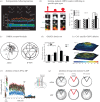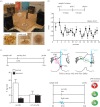The synaptic plasticity and memory hypothesis: encoding, storage and persistence - PubMed (original) (raw)
Review
. 2013 Dec 2;369(1633):20130288.
doi: 10.1098/rstb.2013.0288. Print 2014 Jan 5.
Affiliations
- PMID: 24298167
- PMCID: PMC3843897
- DOI: 10.1098/rstb.2013.0288
Review
The synaptic plasticity and memory hypothesis: encoding, storage and persistence
Tomonori Takeuchi et al. Philos Trans R Soc Lond B Biol Sci. 2013.
Abstract
The synaptic plasticity and memory hypothesis asserts that activity-dependent synaptic plasticity is induced at appropriate synapses during memory formation and is both necessary and sufficient for the encoding and trace storage of the type of memory mediated by the brain area in which it is observed. Criteria for establishing the necessity and sufficiency of such plasticity in mediating trace storage have been identified and are here reviewed in relation to new work using some of the diverse techniques of contemporary neuroscience. Evidence derived using optical imaging, molecular-genetic and optogenetic techniques in conjunction with appropriate behavioural analyses continues to offer support for the idea that changing the strength of connections between neurons is one of the major mechanisms by which engrams are stored in the brain.
Keywords: dopamine; engram; initial consolidation; long-term potentiation; memory; synaptic plasticity.
Figures
Figure 1.
Illustrative findings relevant to the established criteria for assessing the SPM hypothesis. (a,b) Detectability. Field-potentials are increased on some but not all electrodes of a multi-electrode array in area CA1 following inhibitory avoidance learning (Adapted with permission from Whitlock et al. [42] © AAAS) (a). AMPA receptor trafficking detected optically using a GFP label in association with learning, with GluA1 targeted specifically at mature, mushroom-shaped spines (Adapted with permission from Matsuo et al. [43] © AAAS) (b). (c–e) Anterograde alterations. Pharmacological blockade of NMDA receptors in rats with chronic infusion of D-AP5 impairs spatial learning (Adapted with permission from Morris et al. [44]) (c). Genetic knock-out of GluN2A in mice also impairs spatial learning in the watermaze (Adapted with permission from Sakimura et al. [45] © Macmillan Publishers Ltd) (d). CA1 pyramidal cell-specific knockout of GluN1 in mice also impairs selective searching in the watermaze (Adapted with permission from Tsien et al. [46,47] © Elsevier) (e). (f,g) Retrograde alterations. Successful abolition by ZIP of long-lasting LTP 22 h after its initial induction (f). Corresponding abolition of long-term place-memory on a rotating platform by ZIP (Adapted with permission from Pastalkova et al. [48] © AAAS) (g).
Figure 2.
Hypothetical experiment testing the prediction that LTP at a given set of synapses is sufficient for engram formation. (a) Activity-dependent expression of hypothetical Ca2+ channel in hippocampal CA1 area. The IEG promoter-driven tTA transgenic animal is injected with a viral vector in which the hypothetical light- or exogenous ligand-activated Ca2+ channel with tagged synapse-targeting sequence is expressed in an activity-dependent and Dox-regulated manner. (b) Memory encoding in CA1. A specific pattern of activation of afferent fibres results in Hebbian LTP at a fraction of synapses onto CA1 pyramidal cells. (c) Synaptic tagging and capture. In absence of Dox, strong encoding results in formation of synaptic tags and synthesis of not only PRPs but also the hypothetical Ca2+ channel. The channel protein is then distributed around the neuron and captured by the tagged synapses. (d) Trace decay. The animal is put back on Dox. Synaptic potentiation at hypothetical Ca2+ channel-targeted synapses decays with time. (e) LTP reinstatement. Activation of the Ca2+ channel (either by illumination of the target area or infusion of the exogenous ligand) should result in LTP at synapses tagged during the critical encoding session. A successful mimicry experiment would involve a subsequent demonstration of retrieval of the reinstated memory trace. Sch, Schaffer collaterals; PP, perforant path.
Figure 3.
One-shot spatial memory task on the event arena for mice. (a) Event arena for one-shot spatial memory task. The event arena during a daily choice phase. Five sand wells are open but only one contains the reward pellets. All open sand wells contain several pellets that are inaccessible to the mouse in order to control for olfactory artefacts. (b) Daily spatial memory performance (errors). Every day mice have two trials to encode the new sand well location, followed by a choice phase. They quickly reach a stable performance level of less than one error (with two errors being the chance level). (c) Novelty-induced enhancement of memory persistence. Critical sessions involve one sample trial followed by an unrewarded probe test 24 h later. 5 min exploration of a novel environment 30 min after encoding results in enhanced persistence of one-shot spatial memory, as demonstrated by increased dig time in the correct location. (d) Prediction of memory enhancement by optogenetic stimulation of catecholaminergic nuclei. We predict that photoactivation of DA cells of the VTA or DA-releasing NA cells of LC in TH-Cre mice injected with Cre-dependent ChR2 virus (AAV-Flex-ChR2) after weak memory encoding will result in enhancement of memory persistence that mimics the novelty effect. Error bars, ±s.e.m; dotted lines, chance level.
Similar articles
- Synaptic plasticity and memory: an evaluation of the hypothesis.
Martin SJ, Grimwood PD, Morris RG. Martin SJ, et al. Annu Rev Neurosci. 2000;23:649-711. doi: 10.1146/annurev.neuro.23.1.649. Annu Rev Neurosci. 2000. PMID: 10845078 Review. - Elements of a neurobiological theory of the hippocampus: the role of activity-dependent synaptic plasticity in memory.
Morris RG, Moser EI, Riedel G, Martin SJ, Sandin J, Day M, O'Carroll C. Morris RG, et al. Philos Trans R Soc Lond B Biol Sci. 2003 Apr 29;358(1432):773-86. doi: 10.1098/rstb.2002.1264. Philos Trans R Soc Lond B Biol Sci. 2003. PMID: 12744273 Free PMC article. Review. - Strengthened connections between engrams encode specific memories.
Kim JI, Choi DI, Kaang BK. Kim JI, et al. BMB Rep. 2018 Aug;51(8):369-370. doi: 10.5483/BMBRep.2018.51.8.176. BMB Rep. 2018. PMID: 30078390 Free PMC article. - New life in an old idea: the synaptic plasticity and memory hypothesis revisited.
Martin SJ, Morris RG. Martin SJ, et al. Hippocampus. 2002;12(5):609-36. doi: 10.1002/hipo.10107. Hippocampus. 2002. PMID: 12440577 Review. - "The seven sins" of the Hebbian synapse: can the hypothesis of synaptic plasticity explain long-term memory consolidation?
Arshavsky YI. Arshavsky YI. Prog Neurobiol. 2006 Oct;80(3):99-113. doi: 10.1016/j.pneurobio.2006.09.004. Epub 2006 Oct 30. Prog Neurobiol. 2006. PMID: 17074430 Review.
Cited by
- Spatially resolved transcriptomic signatures of hippocampal subregions and _Arc_-expressing ensembles in active place avoidance memory.
Vingan I, Phatarpekar S, Tung VSK, Hernández AI, Evgrafov OV, Alarcon JM. Vingan I, et al. Front Mol Neurosci. 2024 Oct 31;17:1386239. doi: 10.3389/fnmol.2024.1386239. eCollection 2024. Front Mol Neurosci. 2024. PMID: 39544521 Free PMC article. - A Physical Framework to Study the Effect of Magnetic Fields on the Spike-Time Coding.
Rivas M, Martinez-Garcia M. Rivas M, et al. Biomed Eng Comput Biol. 2024 Nov 4;15:11795972241272380. doi: 10.1177/11795972241272380. eCollection 2024. Biomed Eng Comput Biol. 2024. PMID: 39502401 Free PMC article. - Clinical parameters affect the structure and function of superficial pyramidal neurons in the adult human neocortex.
Lenz M, Kruse P, Eichler A, Straehle J, Hemeling H, Stöhr P, Beck J, Vlachos A. Lenz M, et al. Brain Commun. 2024 Oct 7;6(5):fcae351. doi: 10.1093/braincomms/fcae351. eCollection 2024. Brain Commun. 2024. PMID: 39474044 Free PMC article. - The Physiological Mechanisms of Transcranial Direct Current Stimulation to Enhance Motor Performance: A Narrative Review.
Qi S, Cao L, Wang Q, Sheng Y, Yu J, Liang Z. Qi S, et al. Biology (Basel). 2024 Oct 2;13(10):790. doi: 10.3390/biology13100790. Biology (Basel). 2024. PMID: 39452099 Free PMC article. Review. - Information Thermodynamics: From Physics to Neuroscience.
Karbowski J. Karbowski J. Entropy (Basel). 2024 Sep 11;26(9):779. doi: 10.3390/e26090779. Entropy (Basel). 2024. PMID: 39330112 Free PMC article.
References
- Hebb DO. 1949. The organization of behaviour. New York, NY: Wiley.
- Konorski J. 1948. Conditioned reflexes and neuron organisation. Cambridge, UK: Cambridge University Press.
- Kandel ER. 1978. A cell-biological approach to learning. Bethesda, MD: Society for Neuroscience.
Publication types
MeSH terms
Substances
LinkOut - more resources
Full Text Sources
Other Literature Sources
Medical


